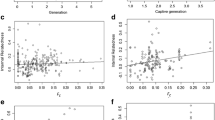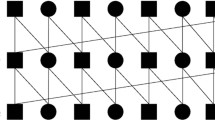Abstract
The genetic management of captive populations to conserve genetic variation is currently based on analyses of individual pedigrees to infer inbreeding and kinship coefficients and values of individuals as breeders. Such analyses require that individual pedigrees are known and individual pairing (mating) can be controlled. Many species in captivity, however, breed in groups due to various reasons, such as space constraints and fertility considerations for species living naturally in social groups, and thus have no pedigrees available for the traditional genetic analyses and management. In the absence of individual pedigree, such group breeding populations can still be genetically monitored, evaluated and managed by suitable population genetics models using population level information (such as census data). This article presents a simple genetic model of group breeding populations to demonstrate how to estimate the genetic variation maintained within and among populations and to optimise management based on these estimates. A numerical example is provided to illustrate the use of the proposed model. Some issues relevant to group breeding, such as the development and robustness evaluation of the population genetics model appropriate for a particular species under specific management and recording systems and the genetic monitoring with markers, are also briefly discussed.
Similar content being viewed by others
References
Ballou JD, Lacy RC (1995) Identifying genetically important individuals for management of genetic variation in pedigreed populations. In:Population Management for Survival and Recovery (eds. Ballou JD, Gilpin M, Foose TJ), pp. 76–111 Columbia University Press, New York.
Ballou JD, Foose TJ (1996) Demographic and genetic man-agement of captive populations. In:Wild Animals in Cap-tivity:Principles and Techniques (eds. Kleiman DG, Allen ME, Thompson KV, Lumpkin S), pp. 263–283. University of Chicago Press, Chicago.
Crow JF, Kimura M (1970) An Introduction to Population Genetics Theory. Harper and Row, New York.
Ely J, Ferrell RE (1990) DNA 'fingerprints 'and paternity as-certainments in chimpanzees. Zoo Biol, 9, 91–98.
Fiumera AC, DeWoody YD, DeWoody JA, Asmussen MA, Avise JC (2001) Accuracy and precision of methods to esti-mate the number of parents contributing to a half-sib progeny array. J. Hered., 92, 120–126.
Frankham R (1995) Conservation genetics. Annu. Rev. Genet., 29, 305–327
Hedrick PW (2001) Conservation genetics:where are we now? Trends. Eco. Evo., 16, 629–636.
Lacy RC (1994) Managing genetic diversity in captive popula-tions of animals. In:Restoration and Recovery of Endangered Plants and Animals (eds. Bowles ML, Whelan CJ), pp. 63–89. Cambridge University Press, Cambridge.
Lacy RC, Ballou JD, Princeée F, Starfiled A, Thompson E (1995) Pedigree analysis. In:Population Management for Survival and Recovery (eds. Ballou JD, Gilpin M, Foose TJ), pp. 57–75. Columbia University Press, New York.
Lynch M, Ritland K (1999) Estimation of pairwise relatedness with molecular markers. Genetics, 152, 1753–1766.
Marshall TC, Slate J, Kruuk LEB, Pemberton JM (1998) Statistical confidence for likelihood-based paternity inference in natural populations. Mol. Ecol. 7, 639–655.
Neff BD, Pitcher TE, Repka J (2002) A Bayesian model for assessing the frequency of multiple mating in nature. J. Hered., 93, 406–414.
Nei M, Roychoudhury AK (1974) Genetic variation within and between the three major races of man, Caucasoids, Negroids, and Mongoloids. Am. J. Hum. Genet., 26, 421–443.
Thomas SC, Hill WG (2000) Estimating quantitative genetic parameters using sibships reconstructed from marker data. Genetics, 155, 1961–1972.
Tomlinson C (1995) Conservation genetics of captive Waldrapp idis. PhD thesis, University of Kent.
Toro M, Silió L, Rodrigáñez J, Rodriguez C, Fernández J (1999) Optimal use of genetic markers in conservation programmes. Genet. Sel. Evol., 31, 255–261.
Vitalis R, Couvet D (2001) Estimation of effective population size and migration rate from one-and two-locus identity measures. Genetics, 157, 911–925.
Wang J (2001) Optimal marker-assisted selection to increase the effective size of small populations. Genetics, 154, 475–489.
Wang J (2002) An estimator for pairwise relatedness using molecular markers. Genetics, 160, 1203–1215.
Wang J (2004) Sibship reconstruction from genetic data with typing errors. Genetics, 166, 1963–1979.
Wang J, Hill WG (2000) Marker assisted selection to increase effective population size by reducing Mendelian segregation variance. Genetics, 154, 475–489.
Wang J, Whitlock MC (2003) Estimating effective population size and migration rates from genetic samples over space and time. Genetics, 163, 429–446.
Weir BS, Hill WG (2002) Estimating F-statistics. Annu. Rev. Genet., 36, 721–750.
Author information
Authors and Affiliations
Rights and permissions
About this article
Cite this article
Wang, J. Monitoring and managing genetic variation in group breeding populations without individual pedigrees. Conservation Genetics 5, 813–825 (2004). https://doi.org/10.1007/s10592-004-1982-6
Issue Date:
DOI: https://doi.org/10.1007/s10592-004-1982-6




